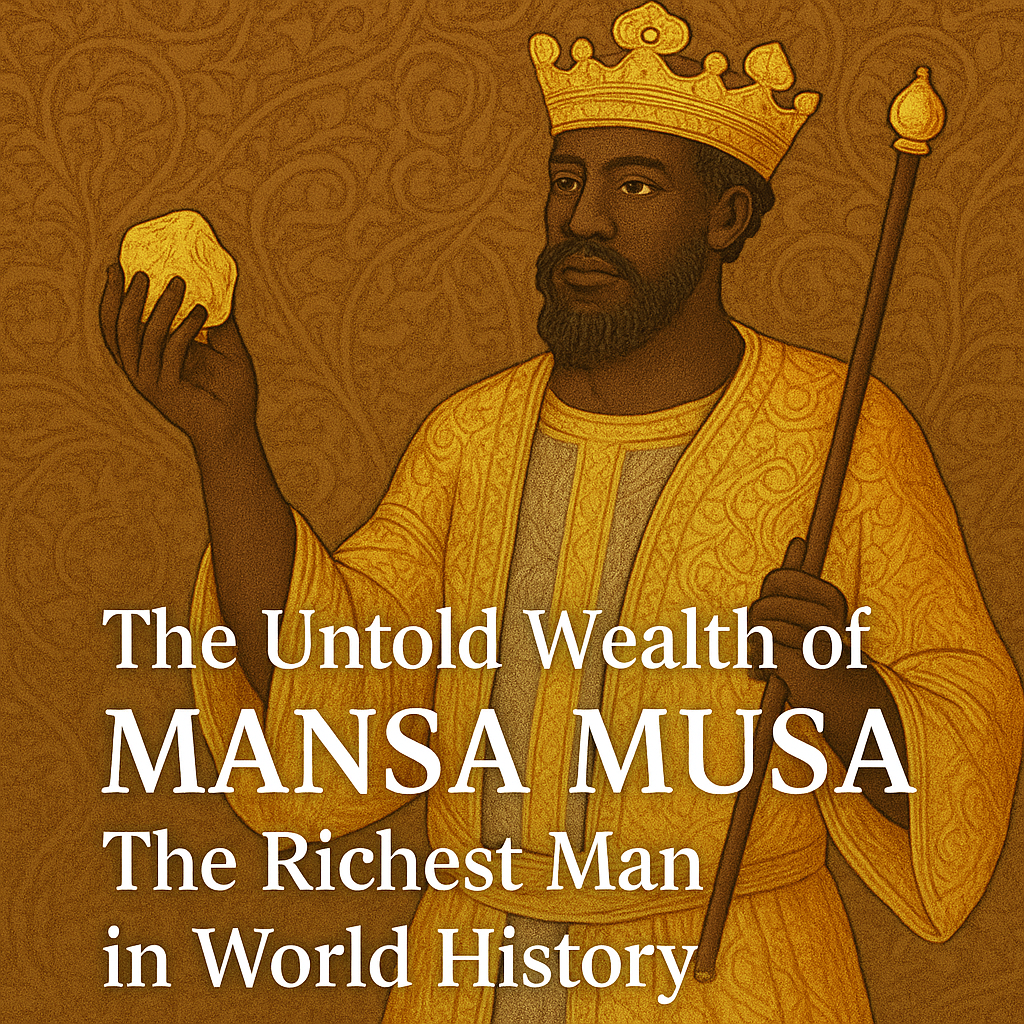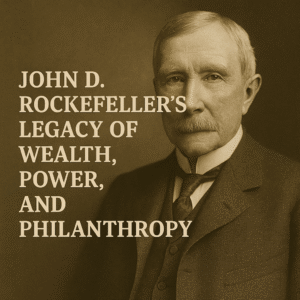When we think about the richest people in history, modern names like Elon Musk, Jeff Bezos, or even historical titans like John D. Rockefeller might come to mind. But what if I told you that none of them come close to the staggering wealth of a 14th-century African king? Meet Mansa Musa, the ruler of the Mali Empire, whose wealth was so immense it literally shook economies and became legend. Yet, outside of African history circles, his story often remains untold.
This post delves deep into the extraordinary life of Mansa Musa—the richest human to ever live—and the golden age of the Mali Empire. From his famous pilgrimage to Mecca that turned heads across the Islamic world, to the rise of Timbuktu as a hub of knowledge and culture, Mansa Musa’s story is one that deserves global recognition.
Who Was Mansa Musa And How Did He Rise To Power
Born in 1280 AD, Mansa Musa I rose to the throne of the Mali Empire in 1312, after the death of his predecessor, Abu-Bakr II. He was not initially in the line of succession but came to power as a deputy after Abu-Bakr reportedly set off on a voyage across the Atlantic Ocean and never returned. What followed was a reign that transformed the empire into one of the largest and wealthiest on Earth.
The Mali Empire, located in West Africa, was already a thriving region by the time Mansa Musa took power. Rich in gold, salt, and other natural resources, it was strategically positioned along trans-Saharan trade routes. But Musa’s leadership brought an unprecedented level of wealth, power, and international influence to Mali.
He expanded the empire significantly, incorporating over 400 cities, stretching from the Atlantic coast deep into the Sahara, and encompassing parts of present-day Senegal, Mauritania, Mali, Burkina Faso, Niger, Nigeria, and Chad.
The Pilgrimage That Shook The World
In 1324, Mansa Musa made a pilgrimage (Hajj) to Mecca, one of the five pillars of Islam. This journey wasn’t just a religious obligation—it was a statement to the world. He didn’t travel alone. Historical accounts describe a caravan of 60,000 men, including soldiers, officials, and attendants. Among them were 12,000 slaves, each carrying 4 pounds of gold, and hundreds of camels each loaded with up to 300 pounds of gold dust.
Along the way, Mansa Musa handed out gold to the poor, built mosques, and engaged in lavish spending in every city he passed through—most famously Cairo, Medina, and Mecca. His generosity was so extravagant that it caused a decade-long inflation crisis in Cairo due to the sudden devaluation of gold.
This pilgrimage had multiple effects. It not only enhanced his spiritual reputation but also introduced Mali to the wider Muslim world. Suddenly, scholars, artists, and architects wanted to travel to this fabled African kingdom. Word of Mansa Musa’s wealth spread across Europe and the Middle East, leading to his appearance on the 1375 Catalan Atlas, one of the most important medieval world maps. In it, Mansa Musa is illustrated sitting on a golden throne, holding a nugget of gold—symbolizing his unmatchable riches.
The Golden Age Of Timbuktu And The Power Of Knowledge
While Musa is remembered for his immense wealth, his contributions to education, architecture, and religion are equally monumental. On his return from Mecca, he brought with him scholars, architects, and books, aiming to make Mali a center of Islamic learning.
Perhaps the greatest symbol of this ambition was Timbuktu. Under Mansa Musa’s rule, it transformed into a vibrant intellectual hub, often referred to as the “Athens of Africa”. He funded the construction of the Sankore University and hundreds of madrassas (Islamic schools), attracting students and thinkers from across North Africa and the Middle East.
Thousands of manuscripts on law, science, mathematics, medicine, astronomy, and Islamic theology were written and preserved in Timbuktu’s libraries. Even centuries later, many of these texts still survive today, offering a glimpse into a forgotten era of African scholarship and advancement.
Musa also built the famous Djinguereber Mosque, which still stands today in Timbuktu. Designed by an Andalusian architect named Abu Es Haq es Saheli, who Musa brought back from his pilgrimage, it was constructed using mudbrick and local materials—setting a standard for Sudano-Sahelian architecture still seen across West Africa.
Just How Rich Was Mansa Musa Really
It’s nearly impossible to accurately estimate Mansa Musa’s net worth. Some modern economists and historians have attempted to put a number on it, with estimates ranging as high as $400 billion in today’s money—more than the GDP of many modern nations.
But Musa’s wealth wasn’t just about cash—it was embedded in land, control of natural resources, international trade, and economic power over entire regions. His empire controlled over half of the world’s gold supply at the time, and he governed the production and trade of this wealth with supreme authority.
Despite the scale of his riches, what makes Musa’s story remarkable is how he used his wealth for nation-building, education, and religion. He didn’t just hoard his fortune; he invested in the future of his empire and its people.
Mansa Musa’s Legacy In Modern Times
Mansa Musa died sometime between 1332 and 1337, and while the exact date is debated, there is no question about the legacy he left behind. His descendants continued to rule Mali for another century, though the empire would eventually decline due to internal strife and the shifting of global trade routes toward the Atlantic coast.
Even so, Mansa Musa’s reign remains a pinnacle in African history. His story disrupts many of the common stereotypes about medieval Africa. Instead of a continent isolated from progress, Musa’s Mali was a global player in trade, education, and religion, interacting with powers as far as Arabia, Spain, and even Venice.
Today, Timbuktu is still celebrated for its historical libraries and manuscripts, many of which are now being preserved as UNESCO World Heritage artifacts. And Mansa Musa’s life continues to inspire not only historians and scholars but also young Africans looking for pride in their heritage.
In recent years, his name has surfaced more frequently in pop culture, education, and media. Documentaries, graphic novels, and podcasts have emerged to reclaim and reframe his story, making it more accessible to the global audience. His life is now seen as a beacon of African excellence—a reminder that the continent has always been home to great leaders, civilizations, and innovators.
Mansa Musa was more than just a rich king—he was a visionary. A man who used his influence to uplift his people, spread knowledge, and leave behind a legacy that still resonates nearly 700 years later.
In an age where Africa is often depicted through the narrow lens of poverty and struggle, Mansa Musa’s story challenges the narrative. His life stands as proof that Africa was—and still is—capable of greatness on a global scale.
Whether you’re a history buff, a student, or simply someone curious about the roots of human civilization, Mansa Musa’s legacy is one worth exploring. His wealth may have made the headlines, but it’s his intellect, generosity, and leadership that made history.
I am working on building a passive income stream using the internet. If you would like to do the same take a look at this business by clicking here.
This business can be operated using the internet and the start up cost is low. I don’t have to leave my current employment to work on building this global business.
If you like what you see, work with me to build a passive income stream using this global business.
I do not provide personal investment or financial advice and I am not a qualified licensed investment advisor. I am documenting my online investment and financial journey and what’s working for me. Click Here to read disclaimer.
If you found value in this post and want to support my work, click here to buy me a coffee.
Subscribe to my list for valuable updates, tools, videos and articles that I will share as I come across them.
Let me know your thoughts on this post via the comments section. You can also add your insights and suggestions.
If you enjoyed reading this post or it added some value, please share it with others.

Follow My Journey And Get Inspired To Transform Your Life For The Better
“I may earn commissions as an affiliate from sponsored links within this post”





